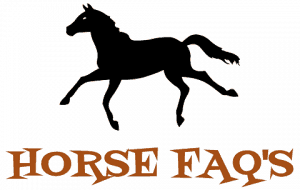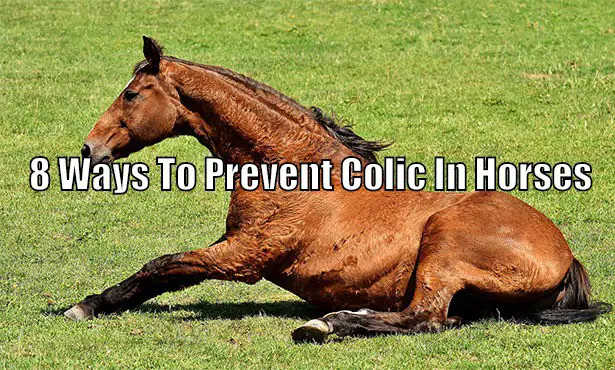8 Ways To Prevent Colic in Horses
Colic is all about pain in a horse’s abdomen. It is a common health concern for people owning horses, especially those who consistently adventure on their horses back. It can be an internal or external cause. The regularity of this condition attributes to the wide treatment techniques. While there are different types of colic depending on the cause, most of them respond positively to treatment.
However, colic can be unpredictable. You will only realize your horse is in pain and unable to move with enthusiasm as before. There are no specific symptoms of a colic attack except the pain that comes with its existence. The good thing is colic can easily be treated at the farm; you don’t have to worry about weeks of engaging a veterinary. In fact, you should learn the therapies as a horse owner.
Symptoms of colic
The fact that Colic is a pointer, it is difficult to describe it with signs. Colic is an indication of pain or issue in the abdomen. While there is no specific sign, you can easily notice your horse is in pain when it demonstrates the following behaviors;
- Rolling or lying down
- Suddenly, it seems to be comfortable facing on one side
- Regular licking of the belly
- Abnormal passing of manure
- Weird feeding and drinking behavior
- Manure filled with mucus or lime
- Decreased ingestion; does not finish the same amount of hay it used to comfortably clear.
- Discolored mucus membranes
- Decreased size of fecal balls
- Increased heart rate
Preventing Colic
Colic might occur several times in a year. While it is common, it doesn’t mean you should assume or get used to it. The fact that your horse is experiencing pain anytime you notice any of the signs, you should be concerned. Research on permanent solution for Colic is still ongoing; there is no cure for colic yet. All horses are prone to these frequent attacks. However, you cannot sit there and wait for an attack to implement traditional care techniques.
There are various ways you can restructure your horse feeding programs and other maintenance practices to prevent occurrence of Colic.
Preventing colic requires research and familiarity with the possible causes. Developing a prevention program is more complex considering every type of colic is unique. It is important to consider all factors relating to feeding, horse barn, and all manner of activity to develop a suitable and relevant plan for your horse. If the plan works for the first year where you don’t detect any colic symptom, do not be too excited. You might be in for a surprise the next minute because your horse maybe experiencing a colic attack, you have never come across.
Be sure to revisit your prevention plans at least every 12 months to alter the feeding and activity plans in case you missed something in the previous plans. Also, change in climate and type of food can trigger infections to your horse including Colic. Just like any infection, Colic takes advantage of a weak immunity to attack your horse.
Actually, most types of colics are not preventable. Still, waiting for an attack before acting is not a plan. You can do better than only waiting. The point is by understanding conditions that make your horse vulnerable to colics helps in developing techniques to reduce the risks. Some risks are unnecessary; it can be because of the diet plan or the environment you expose your horse. If you change this, you have protected your horse at least from 3 types of colics.
The whole point is you should be a proactive horse owner. You know your horse better. Of course, you need to collaborate with a veterinary and barn manager to help you in coming up with a working plan.
Here are some tips to reduce risks of colic attack
1. Regular clean water
You should not keep your horse dehydrated for more than an hour. It is one of the possible causes of colic. Besides presence of water at all ties, you should change the water after every hour if possible. Find a barn manager to keep the water refreshed if you are committed elsewhere. It might seem like a simple task but it has significant effect on health of your horse. If you love your horse and would want to hang out with it for a more years, you must sacrifice the time and resources.
Typically, horses prefer to drink out of buckets. If you are thinking of automatic water systems as a solution to the fresh source, you are wrong. There is no option; someone has to be constantly there to change the water. Freshwater is not only about colic but overall health of your horse. This should not be compromised at any circumstance.
During winter or depending on your location, consider adding few buckets of warm water. Horses tend to drink more water during cold seasons; you can enhance their water intake by warming up the water. Still, keep the refreshing exercise every time.
Consult a veterinary before a long trip. Mineral oil can help in hydrating your horse in between your stops.
Remember, it is about reducing the possible risks. Fresh and constant availability of drinking water may not prevent all types of colic but it can’t be nothing.
2. Pasture mix
Horses that feed from the same hay on a regular basis have high risks of developing colics than a horse with a variety. The simple reason is on quality; irrespective of your hay source, the pasture might be deficient of important minerals. It is therefore important to plan on rotating bales to keep your horse healthy.
Colic takes advantage of nutrient deficiency; rotating 3 pastures helps your horse to stabilize on essential components hence reducing the risk of colics. Weather and storage may also be factors in development of colics.
Pasture turnout helps in making the hay uniform. By the time you get to a specific part of your hay storage, it should have been turned out several times. You should not feed your horse with hay collected months ago and been in the same position
3. Avoid placing hay on sand
When feeding your horse, find a container of suitable size to place the hay. Considering horses feed on big chunks, the container should be wide enough to accommodate size of the mouth.
You should be giving your horse just enough according to veterinary directions. This means it should finish hay each time. If you place it on a sandy surface, the horse will end up ingesting lots of sand that will affect its digestion. Colic being a sign of pain in the abdomen area can develop from such a scenario.
Always use a hayrack or feed tubs. Either of these can be locally constructed; it is only a simple structure to place your hay. If you have limited space or simply don’t like the rack idea, use a rubber mat. Placing a rubber mat or catch pan beneath hay protects the horse from sand ingestion.
4. Avoid whole grain
Pelleted feeds increase the chances of your horse developing colics by a huge percentage. It can be a convenient and easy way to feed a horse but healthy at all. Health is with respect to colics. While it may not result in every type of colic, whole grains are linked to significant digestion difficulty on horses. Regularly feeding your horse with grains only increases health complications. Do not trade your convenience for health of your horse.
5. Only make changes when necessary
Typically, horse owners change feeding patterns and types of feeds after three or four weeks. While it is a healthy strategy with regards to balancing nutrient content in horses, it can increase risks of colics. Actually, colic can emerge because of changing batch of hay.
Besides diet, changes in housing and activity levels should be gradual. Sudden changes affect horse systems and mentality; this increases risks of colic. On feed change, spread the mix over seven days or more, from a week, you can increase the feed percentage on a regular basis.
Stabling changes should also be strategic. Surprises don’t work with horses; it will not only be frustrated but also weak hence prone to infections. Change is fine because you need to adapt to environmental changes and what you seek to achieve with your horse. As the horse grows, you should make changes; however, you should be gradual and smooth just like the growth pattern.
6. Control parasites
Colic types vary widely on basis of sources. Colic can develop because of micro-organisms. Always check for any signs of infection and seek treatment or consult a veterinary immediately. In fact, you don’t have to wait for weird signs from your horse to know it is suffering, you should be keen every time. Set a check-up and deworming schedule. It should be as frequent as possible. Of course, don’t overdo it and affect the natural body functions.
Controlling parasites should be both external and internal. With a regular deworming program, your horse will be safe from colic or nay other health risk.
7. Close monitoring
Consistent and regular care for your care significantly reduces risks of colic. If you are managing the barn on your own, commit time to checking on every body part of your horse. You should be familiar with its behavior and reactions. Horses also have favorite dishes meaning they also don’t like some feeds. You should be close enough to know how it reacts to different weather conditions and environment. You should be able to tell when it is stressed or in high spirits.
If possible, pay a trainer to help you bond with your horse. It is the only way you can detect if it is suffering from colic or any other infection. Close monitoring means you can pick any slight changes in its behavior and make adjustments as early as possible. Just like any other disease, colic can easily be managed if detected early.
8. Be keen on broodmares
If you have a broodmare, you should be more watchful of any weird signs in its behavior. These type of horses are more prone to colics. Also, if your horse has previously been attacked, you need to be extra careful with its behavior. Any trait that doesn’t match its normalcy should worry you.
A horse that has been ill before will likely recur in few months. When buying a horse you should go to details of history and engage a veterinary to know what to expect. Health history is important for confidence on how you will handle future health complications.
What if it is already Colic?
When a horse colics for the first time, it is often a tense moment for a first time owner. The horse can react differently to the pain. It is worse if you were on an adventure on the horse. Usually, walking can help with reducing pain on your horse. However, it is also one of the main causes of colics. It can enhance the pain depending on the type of colic.
If the horse wants to roll as a way of relieving pain, be sure it is on a flat and open area with no objects on the surface that can injure it.
When a horse is thrashing, it must be in extreme pain; you should stay clear to let it handle the pain. The pain can be agonizing and you may be hurt in the process.
If the horse colic is evident in fever, walking it can be a good idea because it can help it adjust temperatures, which will have effect on the pain. In this case, walking will reduce the colic pain effect.
All these should be done while waiting for a veterinary.

